Gas Transition: Renewable Hydrogen’s Future in Eastern Australia’s Energy Networks
Abstract
:1. Introduction
2. Methods
2.1. Scope
2.2. Model
2.3. Assumptions
| Parameter | Value | Unit | References |
|---|---|---|---|
| Discount rate | 6 | % | [36] |
| Electrolyser Operating Life | 20 | years | [34] |
| Methanation Plant Life | 30 | years | [30] |
| Direct Air Capture Plant Life | 30 | years | [38] |
| Commissioning Time | 3 | years | [30] |
3. Results and Discussion
3.1. Growth Scenarios
3.1.1. Gas Blending
3.1.2. Gas Replacement
3.1.3. Electricity Storage
3.2. Cost Assessment
3.2.1. Production to 2050
3.2.2. Valorisation in 2025
3.2.3. Methanation in 2030
3.2.4. Storage in 2050
3.2.5. Wholesale in 2050
3.3. Gas Transition
4. Conclusions
Author Contributions
Funding
Data Availability Statement
Conflicts of Interest
Abbreviations
| AAPL | Australia-ASEAN Power Link | |
| AEMO | Australian Energy Market Operator | |
| AREH | Australian Renewable Energy Hub | |
| ARENA | Australian Renewable Energy Agency | |
| AUD | Australian Dollar | |
| BOP | Balance of Plant | |
| CAPEX | Capital Expenditure | |
| CCM | Catalyst Coated Membrane | |
| CCS | Carbon Capture and Storage | |
| CM | Catalytic Methanation | |
| CSIRO | Commonwealth Scientific and Industrial Research Organisation | |
| DAC | Direct Air Capture | |
| DCF | Discounted Cash Flow | |
| DRI | Direct Reduced Iron | |
| EA | Eastern Australia | |
| EU | European Union | |
| GPG | Gas Powered Generation | |
| GSOO | Gas Statement of Opportunities | |
| HESC | Hydrogen Energy Supply Chain | |
| HHV | Higher Heating Value | MJ/kg |
| ISP | Integrated System Plan | |
| LCOE | Levelised Cost of Energy | AUD/GJ |
| LCOH | Levelised Cost of Hydrogen | AUD/kgH2 |
| LCOS | Levelised Cost of Storage | AUD/kgH2 |
| LCOX | Levelised Cost of X | AUD/GJ |
| LNG | Liquified Natural Gas | |
| MEA | Membrane Electrode Assembly | |
| NEM | National Electricity Market | |
| NSW | New South Wales | |
| NT | Northern Territory | |
| OPEX | Operating Expenditure | |
| O&M | Operations and Maintenance | |
| PEM | Polymer Exchange Membrane | |
| PtG | Power-to-Gas | |
| PV | Photovoltaic | |
| QLD | Queensland | |
| SA | South Australia | |
| SMR | Steam Methane Reforming | |
| TAS | Tasmania | |
| VIC | Victoria | |
| VRE | Variable Renewable Energy | |
| WA | Western Australia |
References
- International Energy Agency. The Future of Hydrogen. 2019. Available online: https://www.iea.org/reports/the-future-of-hydrogen/ (accessed on 14 June 2020).
- Blakers, A.; Baldwin, K.; Stocks, M. Australia, the Global Renewable Energy Pathfinder. 2020. Available online: http://re100.eng.anu.edu.au/news/2020-09-03.php (accessed on 27 January 2021).
- Australian Energy Market Operator. Draft 2021 Inputs, Assumptions and Scenarios Report; AEMO: Melbourne, Australia, 2020. [Google Scholar]
- Energy Networks Australia. Gas Vision 2050. 2020. Available online: https://www.energynetworks.com.au/projects/gas-vision-2050/ (accessed on 19 January 2021).
- Commonwealth of Australia. Australia’s National Hydrogen Strategy. 2019. Available online: https://www.industry.gov.au/data-and-publications/australias-national-hydrogen-strategy (accessed on 10 July 2020).
- Australian Government Department of Industry Science Energy and Resources. National Hydrogen Strategy Priorities and Delivery 2020. Available online: https://www.industry.gov.au/news/national-hydrogen-strategy-priorities-and-delivery-for-2020 (accessed on 22 February 2021).
- International Renewable Energy Agency. Hydrogen: A Renewable Energy Perspective. 2019. Available online: https://www.irena.org/publications/2019/Sep/Hydrogen-A-renewable-energy-perspective (accessed on 14 July 2020).
- Hydrogen Engineering Australia. Hydrogen Energy Supply Chain 2020. Available online: https://hydrogenenergysupplychain.com/ (accessed on 5 August 2020).
- Victoria State Government. The CarbonNet Project 2020. Available online: https://earthresources.vic.gov.au/projects/carbonnet-project (accessed on 5 August 2020).
- Deloitte Access Economics. Decarbonising Australia’s Gas Distribution Networks 2017. Available online: https://www2.deloitte.com/au/en/pages/economics/articles/decarbonising-australias-gas-distribution-networks.html (accessed on 27 January 2021).
- Browne, B. Sunk costs: Carbon Capture and Storage Will Miss Every Target Set for It; The Australia Institute: Canberra, Australia, 2018. [Google Scholar]
- Bloomberg New Energy Finance. Hydrogen Economy Outlook. 2020. Available online: https://assets.bbhub.io/professional/sites/24/BNEF-Hydrogen-Economy-Outlook-Key-Messages-30-Mar-2020.pdf (accessed on 2 September 2020).
- European Commission. A Hydrogen Strategy for a Climate-Neutral Europe; European Comission: Brussels, Belgium, 2020. [Google Scholar]
- Taylor, A.; Birmingham, S.; Pitt, K. Exploring Australia’s Hydrogen Future with Germany 2020. Available online: https://www.minister.industry.gov.au/ministers/taylor/media-releases/exploring-australias-hydrogen-future-germany (accessed on 22 February 2021).
- Saba, S.M.; Müller, M.; Robinius, M.; Stolten, D. The investment costs of electrolysis—A comparison of cost studies from the past 30 years. Int. J. Hydrog. Energy 2018, 43, 1209–1223. [Google Scholar] [CrossRef]
- Quarton, C.J.; Samsatli, S. Power-to-gas for injection into the gas grid: What can we learn from real-life projects, economic assessments and systems modelling? Renew. Sustain. Energy Rev. 2018, 98, 302–316. [Google Scholar] [CrossRef]
- Melaina, M.W.; Penev, M.; Zuboy, J. Hydrogen Blending in Natural Gas Pipelines. In Handbook of Clean Energy Systems; John Wiley & Sons, Ltd.: Chichester, UK, 2015; pp. 1–13. [Google Scholar] [CrossRef]
- Sadler, D.; Cargill, A.; Crowther, M.; Rennie, A.; Watt, J.; Burton, S.; Haines, M.; Trapps, J.; Hand, M.; Pomroy, R.; et al. H21 Leeds City Gate Report. 2016. Available online: https://h21.green/projects/h21-leeds-city-gate/ (accessed on 15 September 2020).
- GPA Engineering. Hydrogen in the Gas Distribution Networks; GPA Engineering: Adelaide, Australia, 2019. [Google Scholar]
- Sampson, J. Worcester Bosch Wants only Hydrogen-Ready Boilers on the Market by 2025; H2 View: Truro, Cornwall, UK, 2020. [Google Scholar]
- Wilson, B. Gas in Australia: Low Carbon Today, Zero Carbon Tomorrow; Australian Institute of Energy: Canberra, Australia, 2020. [Google Scholar]
- Cadent. HyNet North West; Cadent Gas Ltd.: Coventry, United Kingdom, 2020. [Google Scholar]
- Australian Energy Market Operator. 2020 Integrated System Plan. AEMO: Melbourne, Australia, 2020. [Google Scholar]
- BioAge Group. Audi Opens Power-to-Gas Facility in Werlte/Emsland. Green Car Congress 2013. Available online: https://www.greencarcongress.com/2013/06/audi-20130625.html (accessed on 5 March 2021).
- Ogawa, K. Japan to Help Build Giant Methane Production Plant in China. Nikkei 2020. Available online: https://asia.nikkei.com/Spotlight/Environment/Japan-to-help-build-giant-methane-production-plant-in-China (accessed on 20 December 2020).
- Australian Renewable Energy Agency. APA Renewable Methane Demonstration Project 2020. Available online: https://arena.gov.au/news/trialling-renewable-methane-in-australias-gas-pipelines/ (accessed on 10 August 2020).
- Ali Khan, M.H.; Daiyan, R.; Han, Z.; Hablutzel, M.; Haque, N.; Amal, R.; MacGill, I. Designing Optimal Integrated Electricity Supply Configurations for Renewable Hydrogen Generation in Australia. IScience 2021, 24, 102539. [Google Scholar] [CrossRef]
- Dickson, A. The Asian Renewable Energy Hub: Renewable Energy at Oil and Gas Scale; Australian Institute of Energy: Perth, Australia, 2020. [Google Scholar]
- Australian Energy Market Operator. 2020 Gas Statement of Opportunities; AEMO: Melbourne, Australia, 2020. [Google Scholar]
- McDonagh, S.; O’Shea, R.; Wall, D.M.; Deane, J.P.; Murphy, J.D. Modelling of a power-to-gas system to predict the levelised cost of energy of an advanced renewable gaseous transport fuel. Appl. Energy 2018, 215, 444–456. [Google Scholar] [CrossRef]
- Gorre, J.; Ortloff, F.; van Leeuwen, C. Production costs for synthetic methane in 2030 and 2050 of an optimized Power-to-Gas plant with intermediate hydrogen storage. Appl. Energy 2019, 253, 113594. [Google Scholar] [CrossRef]
- IRENA. Green Hydrogen Cost Reduction: Scaling up Electrolysers to Meet the 1.5 °C Climate Goal. Abu Dhabi, United Arab Emirates: 2020. Available online: https://www.irena.org/publications/2020/Dec/Green-hydrogen-cost-reduction (accessed on 7 June 2021).
- Thompson, S.T.; James, B.D.; Huya-Kouadio, J.M.; Houchins, C.; DeSantis, D.A.; Ahluwalia, R.; Wilson, A.R.; Kleen, G.; Papageorgopoulos, D. Direct hydrogen fuel cell electric vehicle cost analysis: System and high-volume manufacturing description, validation, and outlook. J. Power Sources 2018, 399, 304–313. [Google Scholar] [CrossRef]
- Freeman, A.; Miller, D.; Simon, F.; Maloney, R.; Norman, D. Australia’s Hydrogen Future. In Proceedings of the All Energy Australia Virtual Conference, Melbourne, Australia, 6 October–12 November 2020. [Google Scholar]
- Campey, T.; Bruce, S.; Yankos, T.; Hayward, J.; Graham, P.; Reedman, L.; Brinsmead, T.; Deverell, J. Low Emissions Technology Roadmap: Technical Report; CSIRO: Canberra, Australia, 2017. [Google Scholar]
- Graham, P.; Hayward, J.; Foster, J.; Havas, L. GenCost 2020–21: Consultation Draft; CSIRO: Canberra, Australia, 2020. [Google Scholar]
- Yates, J.; Daiyan, R.; Patterson, R.; Egan, R.; Amal, R.; Ho-Baille, A.; Chang, N.L. Techno-economic Analysis of Hydrogen Electrolysis from Off-Grid Stand-Alone Photovoltaics Incorporating Uncertainty Analysis. Cell Rep. Phys. Sci. 2020. [Google Scholar] [CrossRef]
- Fasihi, M.; Efimova, O.; Breyer, C. Techno-economic assessment of CO2 direct air capture plants. J. Clean. Prod. 2019, 224, 957–980. [Google Scholar] [CrossRef]
- Longden, T.; Jotzo, F.; Prasad, M.; Andrews, R. Green Hydrogen Production Costs in AUSTRALIA: Implications of Renewable Energy and Electrolyser Costs; Australian National University: Canberra, Australia, 2020. [Google Scholar]
- Mayyas, A.; Ruth, M.; Pivovar, B.; Bender, G.; Wipke, K. Manufacturing Cost Analysis for Proton Exchange Membrane Water Electrolyzers; National Renewable Energy Laboratory (NREL): Golden, CO, USA, 2019.
- Gilbert, A.Q.; Sovacool, B.K. Looking the wrong way: Bias, renewable electricity, and energy modelling in the United States. Energy 2016, 94, 533–541. [Google Scholar] [CrossRef] [Green Version]
- Teske, S. The IEA World Energy Outlook: A critical review 2000–2020; University of Technology Sydney: Sydney, Australia, 2020. [Google Scholar]
- Bruce, S.; Temminghoff, M.; Hayward, J.; Schmidt, E.; Munnings, C.; Palfreyman, D.; Hartley, P. National Hydrogen Roadmap; CSIRO: Canberra, Australia, 2018. [Google Scholar]
- McAllister, S.; Chen, J.-Y.; Fernandez-Pello, A.C. Fundamentals of Combustion Processes; Springer: New York, NY, USA, 2011. [Google Scholar] [CrossRef]
- Australian Government Department of Industry, Science, Energy and Resources. National Greenhouse Accounts Factors. 2020. Available online: https://www.industry.gov.au/data-and-publications/national-greenhouse-accounts-factors (accessed on 21 January 2021).
- Wright, M.; Hearps, P. Zero Carbon Australia Stationary Energy Plan. 2010. Available online: https://bze.org.au/wp-content/uploads/2021/02/stationary-energy-plan-bze-report-2010.pdf (accessed on 5 March 2021).
- Elliston, B.; Diesendorf, M.; Macgill, I. Simulations of scenarios with 100% renewable electricity in the Australian National Electricity Market. Energy Policy 2012, 45, 606–613. [Google Scholar] [CrossRef]
- Blakers, A.; Lu, B.; Stocks, M. 100% renewable electricity in Australia. Energy 2017, 133, 471–482. [Google Scholar] [CrossRef]
- Australian PV Institute. APVI/ARENA Solar Map. Funded by Aust Renew Energy Agency 2021. Available online: pv-map.apvi.org.au (accessed on 21 January 2021).
- Masson, G.; Kaizuka, I. Trends in Photovoltaic Applications 2019. 2019. Available online: 10.13140/RG.2.2.10332.00647 (accessed on 9 October 2020).
- Australian Energy Regulator. Annual Generation Capacity and Peak Demand—NEM. Wholesale Statistics 2021. Available online: https://www.aer.gov.au/wholesale-markets/wholesale-statistics/annual-generation-capacity-and-peak-demand-nem (accessed on 5 February 2021).
- The Climate Council of Australia. The Australian Renewable Energy Race: Which States are Winning or Losing? Climate Council of Australia Limited: Sydney, Australia, 2014. [Google Scholar]
- Sun Cable. Australia-ASEAN Power Link 2020. Available online: https://www.suncable.sg/ (accessed on 6 August 2020).
- Frontier Economics. The Benefits of Gas Infrastructure to Decarbonise Australia. 2020. Available online: https://www.energynetworks.com.au/resources/reports/2020-reports-and-publications/the-benefits-of-gas-infrastructure-to-decarbonise-australia-frontier-economics/ (accessed on 12 October 2020).
- Haeseldonckx, D.; D’haeseleer, W. The use of the natural-gas pipeline infrastructure for hydrogen transport in a changing market structure. Int. J. Hydrog. Energy 2007, 32, 1381–1386. [Google Scholar] [CrossRef]
- Sepulveda, N.A.; Jenkins, J.D.; Edington, A.; Mallapragada, D.S.; Lester, R.K. The design space for long-duration energy storage in decarbonized power systems. Nat. Energy 2021. [Google Scholar] [CrossRef]
- Ahluwalia, R.K.; Papadias, D.D.; Peng, J.; Roh, H.S. System Level Analysis of Hydrogen Storage Options. 2019. Available online: https://www.hydrogen.energy.gov/pdfs/review19/st001_ahluwalia_2019_o.pdf (accessed on 15 September 2020).
- Gurieff, N.; Green, D.; Koskinen, I.; Lipson, M.; Baldry, M.; Maddocks, A.; Menictas, C.; Noack, J.; Moghtaderi, B.; Doroodchi, E. Healthy Power: Reimagining Hospitals as Sustainable Energy Hubs. Sustainability 2020, 12, 8554. [Google Scholar] [CrossRef]
- Boon, A.G. Use of oxygen in the treatment of waste water. H2O 1977, 10, 219–222. [Google Scholar]
- Brand, E.; Gray, E.; Ashworth, P.; Hodgson, P.; Broadbent, A. Hydrogen Unpacked: Learnings on the adoption of hydrogen in Australia and globally. In Proceedings of the National Cleantech Conference, Brisbane, Australia, 24–26 November 2020. [Google Scholar]
- Breyer, C.; Tsupari, E.; Tikka, V.; Vainikka, P. Power-to-gas as an emerging profitable business through creating an integrated value chain. Energy Procedia 2015, 73, 182–189. [Google Scholar] [CrossRef] [Green Version]
- Percy, S.; Hayward, J.; McConnell, D. Electricity Storage Economics: Contemporary Developments. In Proceedings of the ERICA Webinar Series, Melbourne, Australia, 10 December 2020. [Google Scholar]
- Aurecon. Large-Scale Battery Storage Knowledge Sharing Report. 2019. Available online: https://arena.gov.au/knowledge-bank/large-scale-battery-storage-knowledge-sharing-report/ (accessed on 22 January 2021).
- Liu, W.; Cui, Y.; Du, X.; Zhang, Z.; Chao, Z.; Deng, Y. High efficiency hydrogen evolution from native biomass electrolysis. Energy Environ. Sci. 2016, 9, 467–472. [Google Scholar] [CrossRef]
- Chen, Y.X.; Lavacchi, A.; Miller, H.A.; Bevilacqua, M.; Filippi, J.; Innocenti, M.; Marchionni, A.; Oberhauser, W.; Wang, L.; Vizza, F. Nanotechnology makes biomass electrolysis more energy efficient than water electrolysis. Nat. Commun. 2014, 5, 1–6. [Google Scholar] [CrossRef]
- Australian Competition & Consumer Commission. Gas Inquiry 2017–2025. 2021. Available online: https://www.accc.gov.au/publications/serial-publications/gas-inquiry-2017-2025 (accessed on 4 March 2020).
- McConnell, D.; Sandiford, M. Impacts of LNG Export and Market Power on Australian Electricity Market Dynamics, 2016–2019. Curr. Sustain. Energy Rep. 2020, 7, 176–185. [Google Scholar] [CrossRef]
- Sun, J.; Alam, D.; Daiyan, R.; Masood, H.; Zhang, T.; Zhou, R.; Cullen, P.J.; Lovell, E.C.; Jalili, A.R.; Amal, R. A hybrid plasma electrocatalytic process for sustainable ammonia production. Energy Environ. Sci. 2021, 14. [Google Scholar] [CrossRef]
- Commonwealth of Australia. Hydrogen for Australia’s Future. 2018. Available online: https://arena.gov.au/knowledge-bank/hydrogen-for-australias-future/ (accessed on 27 January 2021).
- Graham, P.; Hayward, J.; Foster, J.; Havas, L. GenCost 2019–20. 2020. Available online: https://doi.org/10.25919/5eb5ac371d372 (accessed on 14 October 2020).
- Henni, S.; Staudt, P.; Kandiah, B.; Weinhardt, C. Infrastructural coupling of the electricity and gas distribution grid to reduce renewable energy curtailment. Appl. Energy 2021, 288, 116597. [Google Scholar] [CrossRef]
- International Energy Agency. Methane Tracker 2021. 2021. Available online: https://www.iea.org/reports/methane-tracker-2021 (accessed on 25 January 2021).
- Pilpola, S.; Lund, P.D. Analyzing the effects of uncertainties on the modelling of low-carbon energy system pathways. Energy 2020, 201, 117652. [Google Scholar] [CrossRef]
- Hamilton, S.; Court, S.H.À. Australia Needs a Green Hydrogen Target. Here’s Why; The Canberra Times: Fyshwick, ACT, Australia, 2021. [Google Scholar]
- Wood, T.; Dundas, G. Flame Out. 2020. Available online: https://grattan.edu.au/report/flame-out-the-future-of-natural-gas/ (accessed on 16 November 2020).
- Liebreich, M.; Separating Hype from Hydrogen—Part 2: The Demand Side. BloombergNEF 2020. Available online: https://about.bnef.com/blog/liebreich-separating-hype-from-hydrogen-part-two-the-demand-side/ (accessed on 16 October 2020).
- AGIG. Using hydrogen to decarbonise natural gas consumption in Victoria is 40% less expensive than full electrification. 2018. Available online: https://www.energynetworks.com.au/resources/reports/decarbonising-victorian-gas-consumption-australian-gas-infrastructure-group/ (accessed on 27 January 2021).
- Hydrogen Council, McKinsey & Company. Hydrogen Insights. 2021. Available online: https://hydrogencouncil.com/en/hydrogen-insights-2021/ (accessed on 3 June 2021).
- Nastasi, B.; Lo Basso, G. Hydrogen to link heat and electricity in the transition towards future Smart Energy Systems. Energy 2016, 110, 5–22. [Google Scholar] [CrossRef]
- Schmidt, O.; Melchior, S.; Hawkes, A.; Staffell, I. Projecting the Future Levelized Cost of Electricity Storage Technologies. Joule 2019, 3, 81–100. [Google Scholar] [CrossRef] [Green Version]
- AEMO Planning and Forecasting. Draft 2021 Inputs, Assumptions and Scenarios Consultation Feedback. 2021. Available online: https://aemo.com.au/en/consultations/current-and-closed-consultations/2021-planning-and-forecasting-consultation-on-inputs-assumptions-and-scenarios (accessed on 4 March 2021).
- Siemens Energy. Power-to-X: The Crucial Business on the Way to a Carbon-Free World. Texas, USA: 2020. Available online: https://www.siemens-energy.com/global/en/offerings/technical-papers/download-power-to-x.html (accessed on 22 July 2020).
- Deloitte Touche Tohmatsu. Australian and Global Hydrogen Demand Growth Scenario Analysis (Erratum). 2020. Available online: https://energyministers.gov.au/sites/prod.energycouncil/files/publications/documents/Erratum%20-%20COAG%20report%20_Accessible%20version.pdf (accessed on 4 August 2020).
- Wood, T.; Dundas, G.; Ha, J. Start with Steel. 2020. Available online: https://grattan.edu.au/report/start-with-steel/ (accessed on 4 August 2020).
- Deloitte Touche Tohmatsu. Australian and Global Hydrogen Demand Growth Scenario Analysis. 2019. Available online: https://www2.deloitte.com/content/dam/Deloitte/au/Documents/future-of-cities/deloitte-au-australian-global-hydrogen-demand-growth-scenario-analysis-091219.pdf (accessed on 4 August 2020).


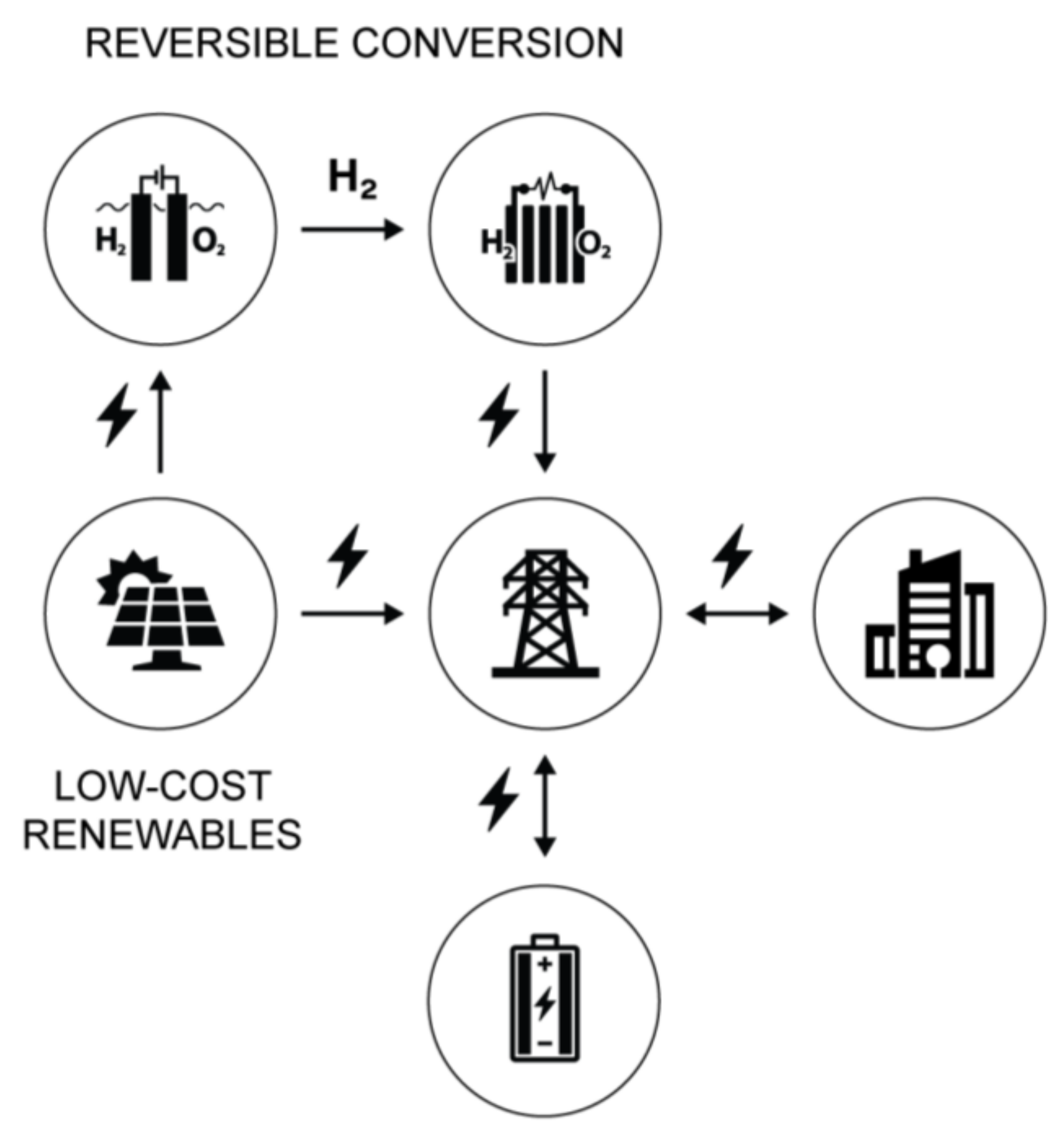

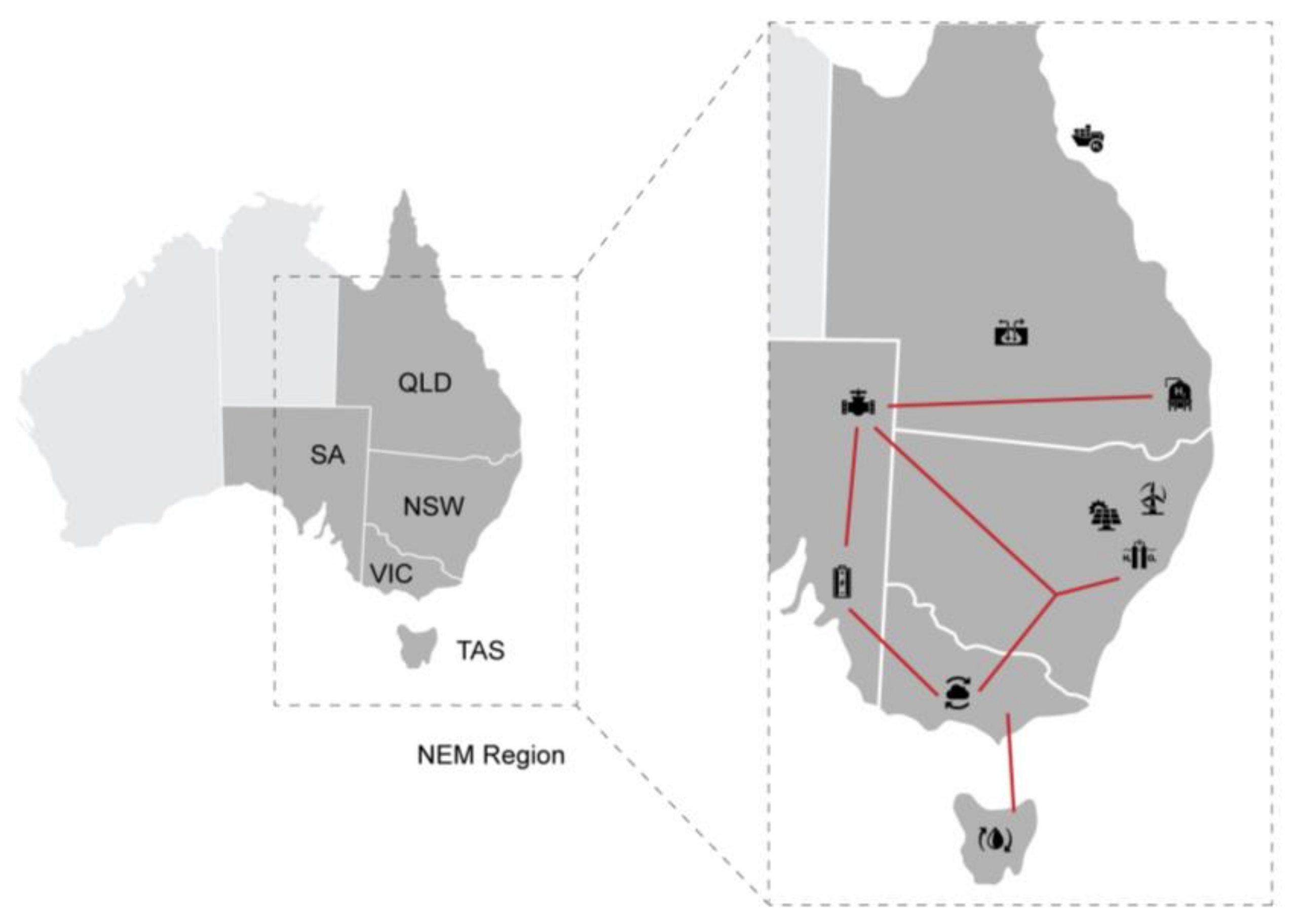
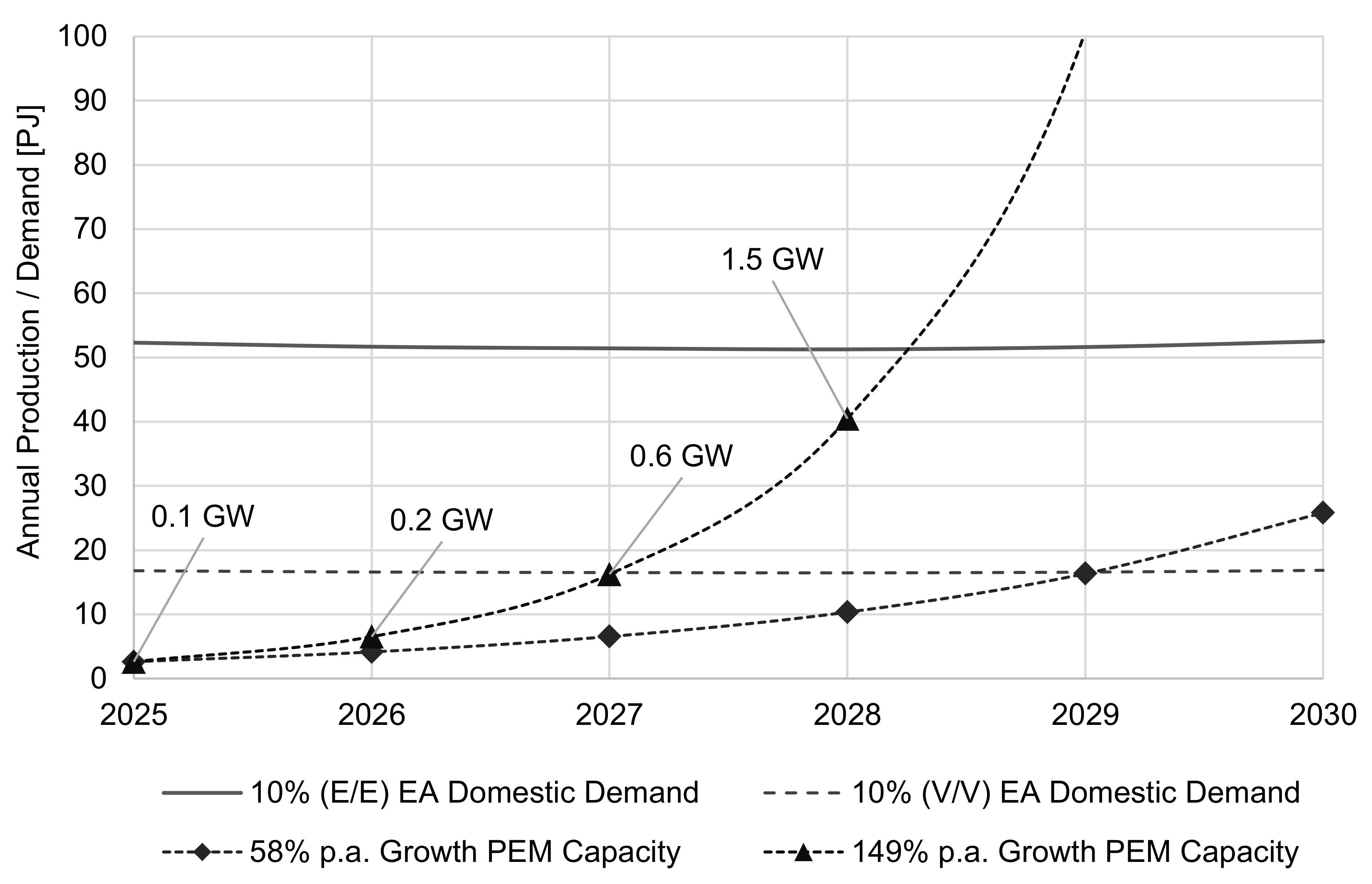



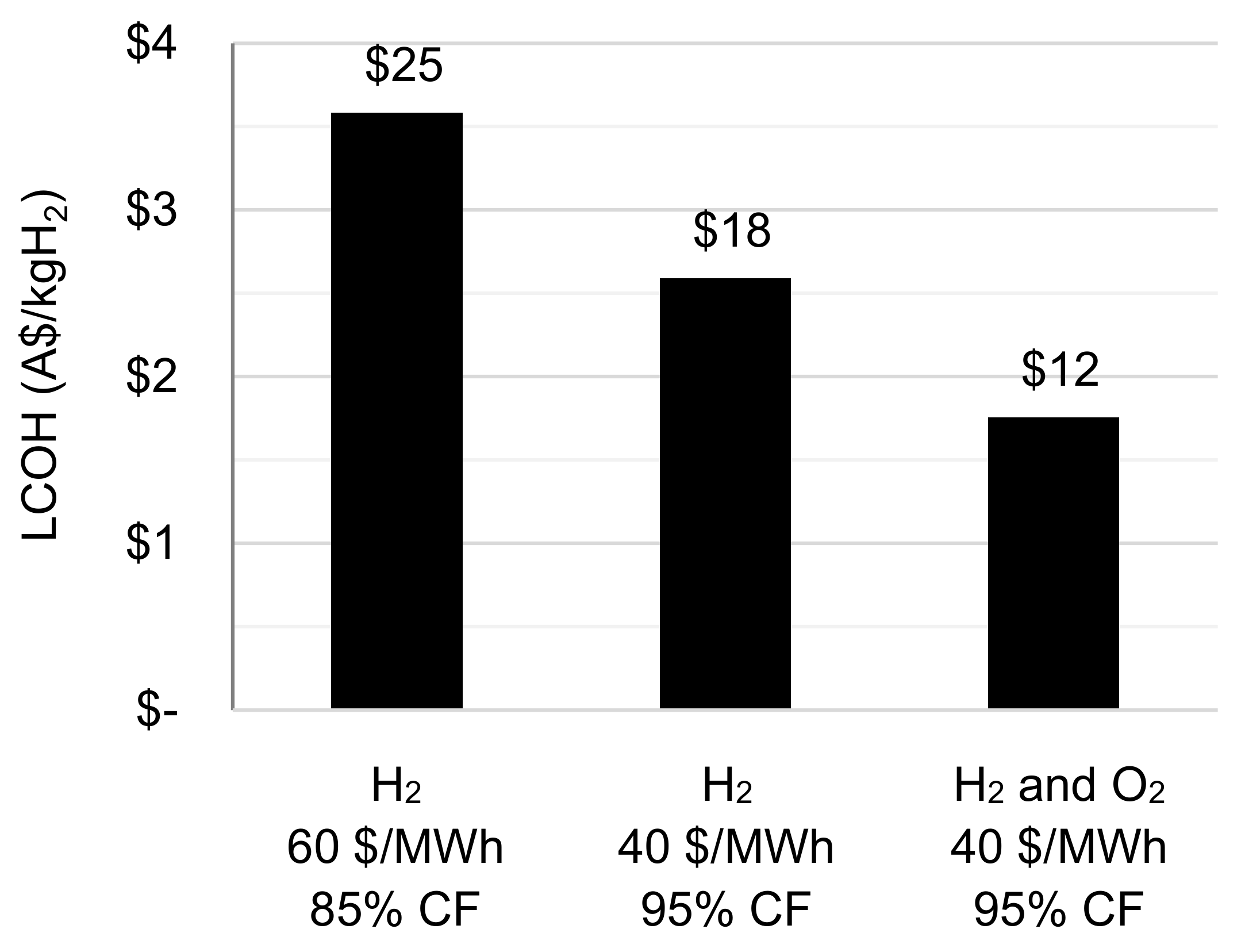
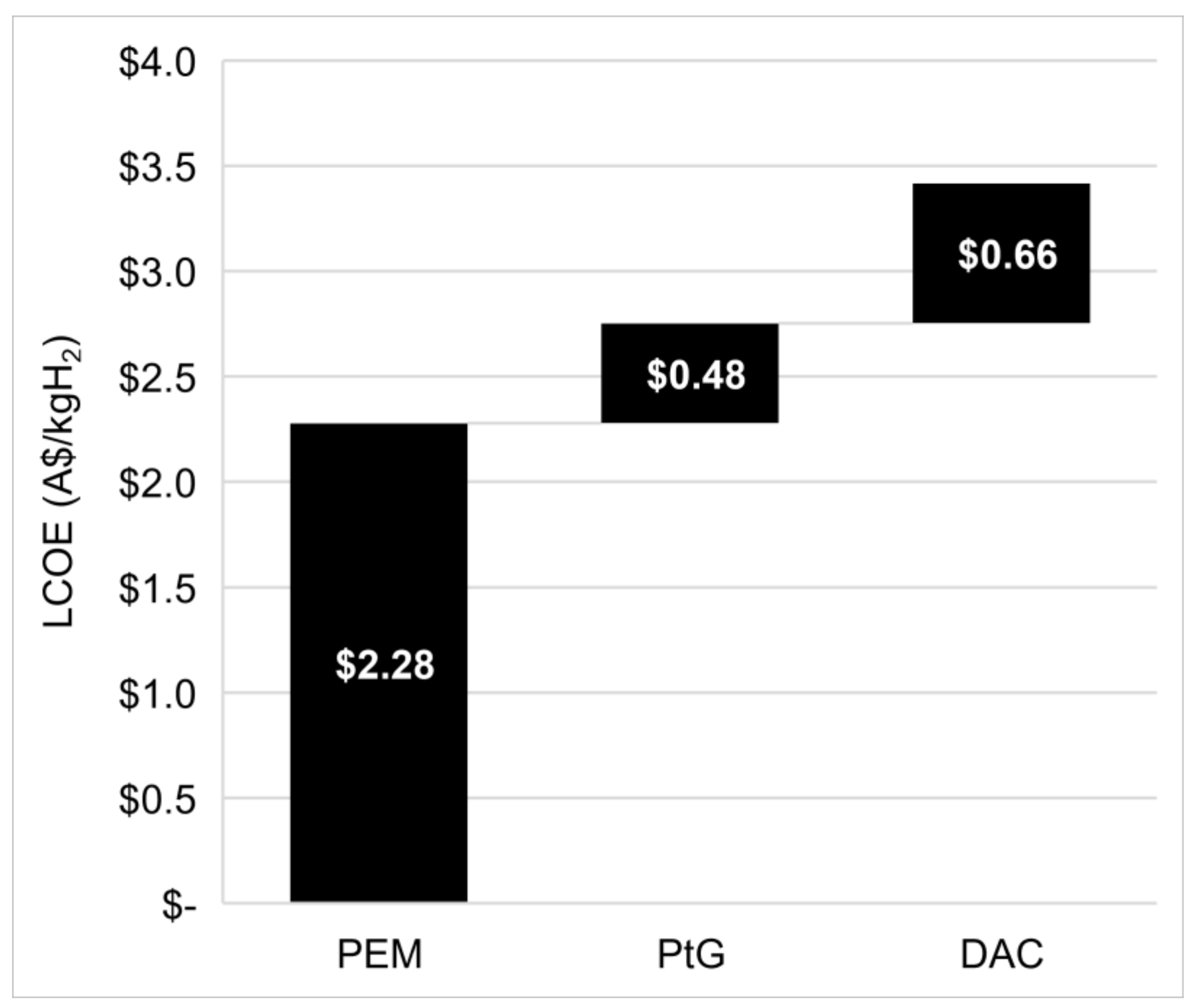


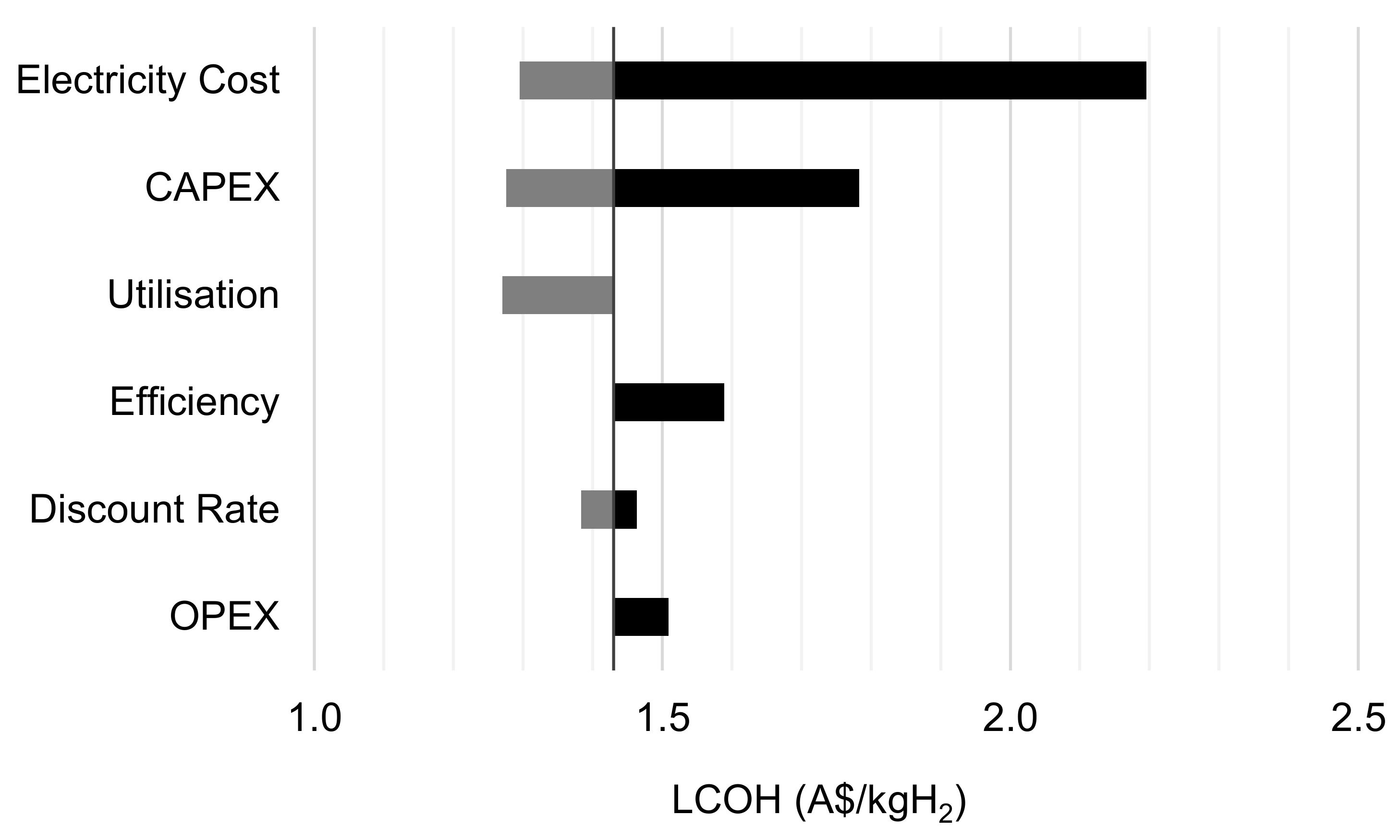
Publisher’s Note: MDPI stays neutral with regard to jurisdictional claims in published maps and institutional affiliations. |
© 2021 by the authors. Licensee MDPI, Basel, Switzerland. This article is an open access article distributed under the terms and conditions of the Creative Commons Attribution (CC BY) license (https://creativecommons.org/licenses/by/4.0/).
Share and Cite
Gurieff, N.; Moghtaderi, B.; Daiyan, R.; Amal, R. Gas Transition: Renewable Hydrogen’s Future in Eastern Australia’s Energy Networks. Energies 2021, 14, 3968. https://doi.org/10.3390/en14133968
Gurieff N, Moghtaderi B, Daiyan R, Amal R. Gas Transition: Renewable Hydrogen’s Future in Eastern Australia’s Energy Networks. Energies. 2021; 14(13):3968. https://doi.org/10.3390/en14133968
Chicago/Turabian StyleGurieff, Nicholas, Behdad Moghtaderi, Rahman Daiyan, and Rose Amal. 2021. "Gas Transition: Renewable Hydrogen’s Future in Eastern Australia’s Energy Networks" Energies 14, no. 13: 3968. https://doi.org/10.3390/en14133968
APA StyleGurieff, N., Moghtaderi, B., Daiyan, R., & Amal, R. (2021). Gas Transition: Renewable Hydrogen’s Future in Eastern Australia’s Energy Networks. Energies, 14(13), 3968. https://doi.org/10.3390/en14133968








